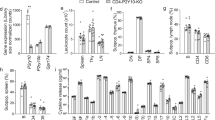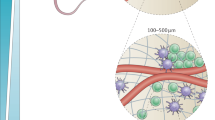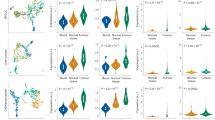Abstract
Movement towards or away from a given stimulus guides the directional migration of prokaryotes, simple eukaryotes and neurons. As bi-directional cues may influence entry and exit of immune effector cells from tissue sites, we evaluated the migratory responses of T-cell subsets to varying concentrations of the chemokine stromal cell derived factor-1 (SDF-1). There was selective repulsion of subpopulations of T cells at high concentrations of recombinant SDF-1 or naturally occurring bone marrow-derived SDF-1, which could be inhibited by pertussis toxin and antibody against the chemokine receptor CXCR4. Distinct sensitivity profiles to genistein, herbimycin and 8-Br-cAMP biochemically distinguished movement of cells towards or away from an SDF-1 gradient. In vivo, antigen-induced T-cell recruitment into the peritoneal cavity was reversed by high but not low concentrations of SDF-1. The phenomenon of movement away from a chemokine represents a previously unknown mechanism regulating the localization of mature T cells. It adds to the functional repertoire of chemokines that may participate in immune physiology and may be applied therapeutically to alter the immune response.
This is a preview of subscription content, access via your institution
Access options
Subscribe to this journal
Receive 12 print issues and online access
$209.00 per year
only $17.42 per issue
Buy this article
- Purchase on Springer Link
- Instant access to full article PDF
Prices may be subject to local taxes which are calculated during checkout





Similar content being viewed by others
References
Bailey, G.B., Leitch, G.J. & Day, D.B. Chemotaxis by entamoeba histolytica. J. Protozool. 32, 341–346 ( 1985).
Dunn, G. in Biology of the Chemotactic Response (eds. J.P. Armitage and J.M. Lackie) 1–14 Cambridge University Press, Cambridge, UK, 1990).
Wilkinson, P. in Biology of the Chemotactic Response (eds. J.P. Armitage and J.M. Lackie) 323–346 (Cambridge University Press, Cambridge, UK, 1990).
Tso, W.W. & Adler, J. Negative chemotaxis in escherichia coli. J. Bacteriol. 118, 560 ( 1974).
Keating, M.T. & Bonner, J.T. Negative chemotaxis in cellular slime molds. J. Bacteriol. 130, 144– 147 (1977).
Ward, M.J. & Zusman, D.R. Regulation of directed motility in Myxococcus xanthus. Mol. Microbiol. 24, 885–893 (1997).
Taylor, B.L. & Johnson, M.S. Rewiring a receptor: negative output from positive input. FEBS Lett. 425, 377–381 (1998).
Dodd, J. & Schuchardt, A. Axon guidance: a compelling case for repelling growth cones. Cell 81, 471 –474 (1995).
Colormarino, S.A. & Tessier-Lavigne, M. The axonal chemoattractant is also chemorepellent for trochlear motor axons. Cell 81, 621–629 ( 1995).
Wu, W. et al. Directional guidance of neuronal migration in the olfactory system by the protein Slit. Nature 400, 331– 336 (1999).
Hong, K. et al. A ligand-gated association between cytoplasmic domains of UNC5 and DCC family receptors converts netrin-induced growth cone attraction to repulsion. Cell 97, 927– 941 (1999).
Bashaw, G.J. & Goodman, C.S. Chimeric axon guidance receptors: the cytoplasmic domains of slit and netrin receptors specify attraction versus repulsion. Cell 97, 917– 926 (1999).
Seeger, M.A. & Beattie, C.E. Attraction versus repulsion: modular receptors make the difference in axon guidance. Cell 97, 821–824 (1999).
Song, H. et al. Conversion of neuronal growth cone responses from repulsion to attraction by cyclic nucleotides. Science 281, 1515–1518 (1998).
Luster, A.D. Chemokines-chemotactic cytokines that mediate inflammation. N. Engl. J. Med. 338, 436–445 (1998).
Baggiolini, M. Chemokines and leukocyte traffic. Nature 392, 565–568 (1998).
Wells, T.N., Power, C.A. & Proudfoot, A.E. Definition, function and pathophysiological significance of chemokine receptors. Trends Pharmacol. Sci. 19, 376–380 (1998).
Bleul, C.C. et al. The lymphocyte chemoattractant SDF-1 is a ligand for LESTR/fusin and blocks HIV-1 entry. Nature 38, 829– 833 (1996).
Nagasawa, T. et al. Defects of B-cell lymphopoiesis and bone marrow myelopoiesis in mice lacking the CXC chemokine PBSF/SDF-1. Nature 382, 635–638 (1996).
Oberlin, E. et al. The CXC chemokine SDF-1 is the ligand for LESTR/fusin and prevents infection by T-cell-line-adapted HIV-1. Nature 382, 833–835 (1996).
Bleul, C.C., Fuhlbrigge, R.C., Casasnovas, J.M., Aiuti, A. & Springer, T.A. A highly efficacious lymphocyte chemoattractant, stromal cell-derived factor 1 (SDF-1). J. Exp. Med. 184, 1101–1109 ( 1996).
Kim, C.H., Pelus, L.M., White, J.R. & Broxmeyer, H.E. Differential chemotactic behavior of developing T-cells in response to thymic chemokines . Blood 91, 4434–4443 (1998).
Feng, Y., Broder, C.C., Kennedy, P.E. & Berger, E.A. HIV-1 entry cofactor: Functional cDNA cloning of a seven-transmembrane, G protein-coupled receptor. Science 272, 872 (1996).
Tashiro, K. et al. Signal sequence trap: a cloning strategy for secreted proteins and type I membrane proteins. Science 261, 600–603 (1993).
Shirozu, M. et al. Structure and chromosomal localization of the human stromal cell-derived factor 1 (SDF1) gene. Genomics 28, 495–500 (1995).
Turner, L., Ward, S.G. & Westwick, J. RANTES-activated human T lymphocytes. A role for phosphoinositide 3-kinase. J. Immunol. 155, 2437– 2444 (1995).
Turner, S.J., Ward, S.G. & Westiwick, J. Stimulation of tyrosine phosphorylation and phosphatidylinositol 3-kinase by MCP-1 in THP-1 cells. Biochem. Soc. Trans. 2, 216S (1977).
Ganju, R.K. et al. The alpha-chemokine, stromal cell-derived factor-1alpha, binds to the transmembrane G-protein-coupled CXCR-4 receptor and activates multiple signal transduction pathways. J. Biol. Chem. 273, 23169–23175 (1998).
Daaka, Y., Luttrell, L.M. & Lefkowitz, R.J. Switching of the coupling of the beta2-adrenergic receptor to different G proteins by protein kinase A. Nature 390, 88–91 (1997).
Selbie, L.A. & Hill, S.J. G protein-coupled-receptor cross-talk: the fine-tuning of multiple receptor-signaling pathways. Trends Pharmacol. Sci. 19, 87–93 (1998).
Bacon, K.B., Premack, B.A., Gardner, P. & Schall, T.J. Activation of dual T-cell signaling pathways by the chemokine RANTES. Science 269, 1727–1730 ( 1995).
Hoogewerf, A.J. et al. Glycosaminoglycans mediate cell surface oligomerization of chemokines. Biochemistry 36, 13570– 13578 (1997).
Sutherland, HJ, Lansdorp, PM, Henkelman, DH, Eaves, AC, Eaves CJ . Functional characterization of individual human hematopoietic stem cells cultured at limiting dilution on supportive marrow stromal layers. Proc. Natl. Acad. Sci. USA 87 :3584 (1990).
Author information
Authors and Affiliations
Corresponding author
Rights and permissions
About this article
Cite this article
Poznansky, M., Olszak, I., Foxall, R. et al. Active movement of T cells away from a chemokine. Nat Med 6, 543–548 (2000). https://doi.org/10.1038/75022
Received:
Accepted:
Issue Date:
DOI: https://doi.org/10.1038/75022
This article is cited by
-
High density of CXCL12-positive immune cell infiltration predicts chemosensitivity and recurrence-free survival in ovarian carcinoma
Journal of Cancer Research and Clinical Oncology (2023)
-
Identification of stress-related genes by co-expression network analysis based on the improved turbot genome
Scientific Data (2022)
-
Targeting regulator of G protein signaling 1 in tumor-specific T cells enhances their trafficking to breast cancer
Nature Immunology (2021)
-
The Role of Immunological Synapse in Predicting the Efficacy of Chimeric Antigen Receptor (CAR) Immunotherapy
Cell Communication and Signaling (2020)
-
GM-CSF and CXCR4 define a T helper cell signature in multiple sclerosis
Nature Medicine (2019)



